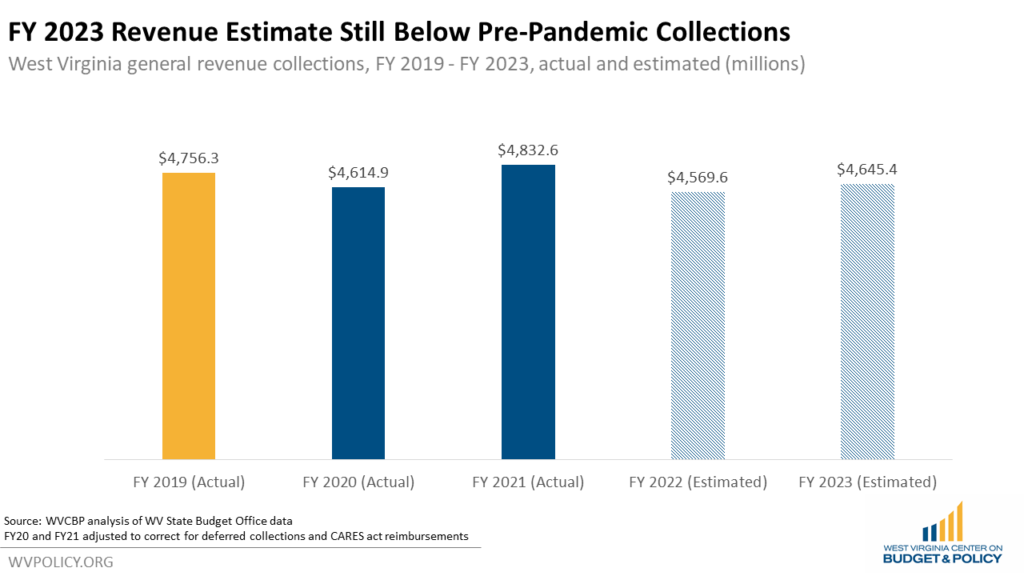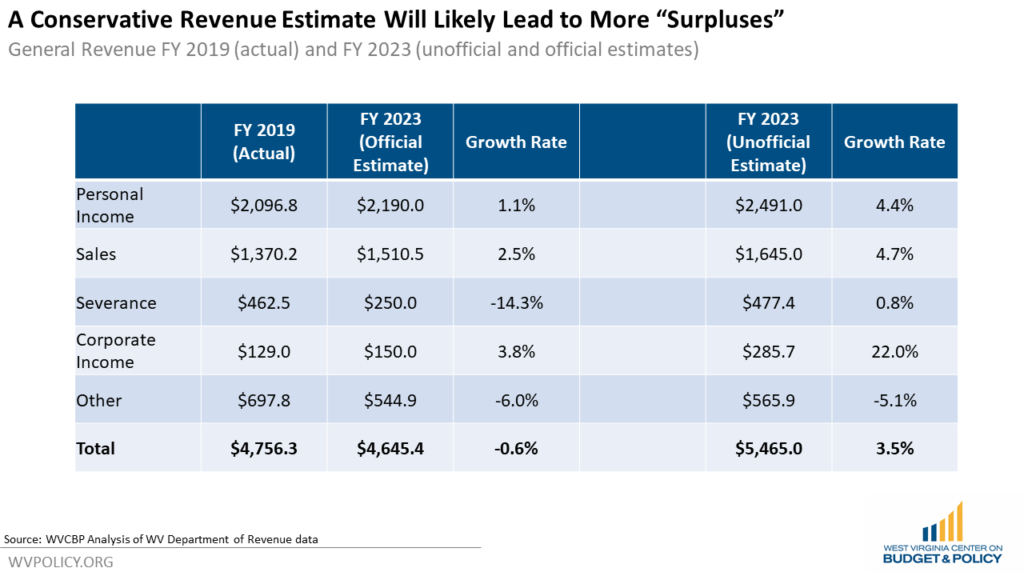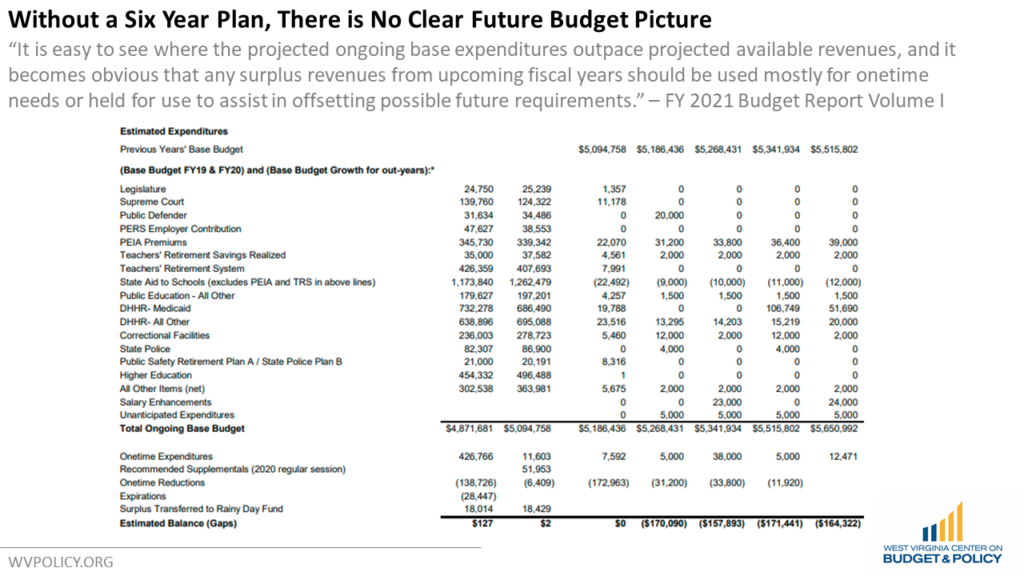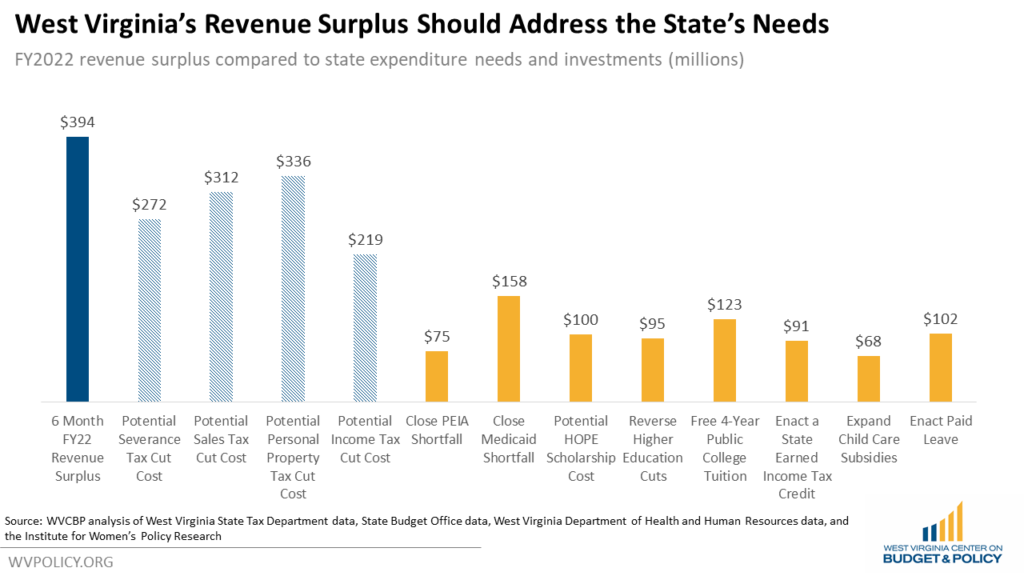Earlier this month, Governor Justice released his FY 2023 budget proposal. Once again, the governor is proposing a relatively “flat” budget with few changes from the previous year. However, like with the FY 2022 budget, low revenue estimates and a lack of a six-year plan are complicating the budget picture, preventing investments in the state’s needs, and will likely generate misleading revenue “surpluses.”
As of December 2021, West Virginia’s FY 2022 budget is running a healthy surplus, with revenue collections exceeding estimates by $394 million. However, much of the revenue surplus is due to a low revenue estimate for FY 2022. Despite the state experiencing a slow and steady recovery throughout the year, the revenue estimate for FY 2022 was $263.0 million below actual revenue collections in FY 2021, and $45.3 million below actual revenue collections in FY 2020, years that were both strongly impacted by the pandemic.
The revenue estimate for FY 2023 is only $75.8 million above the estimate for FY 2022, despite the fact that the revenue collections for FY 2022 are already $394 million above the estimate.

There are reasons to be conservative with the FY 2023 revenue estimate. The state’s economy has been showing signs of slowing in recent months, and much of the federal aid that provided a boost to state revenue collections over the past two years is now gone. In their presentations to the Senate Finance Committee, Secretary of Revenue Dave Hardy and Deputy Secretary Mark Muchow warned of “surprising inexplicable patterns” in revenue collections, due to the pandemic, federal aid, and energy prices. However, unofficial revenue estimates provided to the Finance Committee show that the FY 2023 official estimates may be overly conservative.
The state’s unofficial revenue estimate for FY 2023 is $5.465 billion. That would be $632.4 million above actual collections in FY 2021, and $888.7 million above actual collections in FY 2019, the last year unaffected by the pandemic. Collections of $5.465 billion in FY 2023 would give revenue collections an average annual growth rate of 3.5 percent per year from FY 2019 to FY 2023, which is higher than the state’s historical revenue growth rates, which averaged 2.0 percent from FY 2009 to FY 2019. Current revenue collections suggest that level of growth is possible, but again, current revenue collections have been boosted by high energy prices and federal aid, which prompted the governor to request a lower official revenue estimate for FY 2023.
The state’s official FY 2023 revenue estimate is significantly lower than the aforementioned unofficial estimate. At just $4.654 billion, the FY 2023 revenue estimate is $187 million below actual collections in FY 2021, and $102 million below the FY 2019 (pre-pandemic) actual collections. This would give the FY 2023 revenue collections an average growth rate of -0.6 percent, well below the historical average growth rate of 2.0 percent, and implies that the state’s economy will take a step back in FY 2023, despite the state’s economic outlook projecting the state’s recovery will continue.

While the withdrawal of federal aid and the ongoing pandemic means that West Virginia may not experience the significant revenue growth in FY 2023 that the unofficial revenue estimate suggests, it is also unlikely that revenue will decline in FY 2023, as the official revenue estimate suggests. As such, West Virginia will likely see significant revenue surpluses once again fueled not by the state’s financial strength, but by low revenue estimates.
Legislators cannot exceed the governor’s revenue estimates when crafting their versions of the state budget. So while a low revenue estimate can be used to manufacture headline grabbing “surpluses,” legislators are unable to make new investments in education, health, families, and workers, and instead are left with “flat budgets” that do not address the state’s needs.
Further complicating the picture is the lack of a six-year plan in the governor’s budget proposal. For the second year in a row, Governor Justice’s budget does not include a six-year plan, despite requests from legislators. The six-year plan would outline spending plans for future years and is an essential tool for identifying future needs and structural issues within the budget. Previous six-year plans showed significant budget gaps in the coming years, with Medicaid and PEIA facing funding shortfalls in FY 2024 and FY 2025.

Despite the lack of critical information on future needs from the six-year plan, and with low revenue estimates creating the appearance of fiscal strength, legislators have already targeted the FY 2022 surplus to pay for a variety of tax cuts, including cuts to the severance tax, sales tax, and personal income tax. This could spell trouble for the state’s financial future. As the governor’s FY 2021 budget message noted, current and future surpluses should be used cautiously for one-time needs or held for use to assist in offsetting future budget requirements. Artificially inflating the surplus with low revenue estimates while neglecting the state’s needs in order to justify tax cuts is not a sound fiscal strategy.
